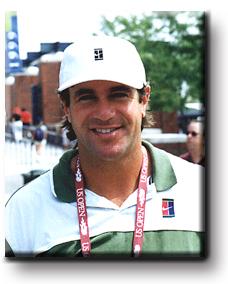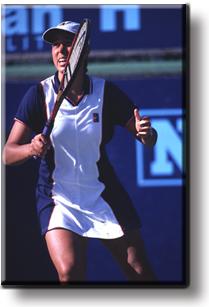<% ns_puts [mkm_getnavbar] %>
Interview with
Craig Kardon, USTA National Coach
Craig Kardon is best known as Martina Navratilova’s
coach during the second half of her incredible career. His
face became familiar to tennis fans as he sat courtside during Martina’s
matches exhibiting a characteristic calm and positive demeanor.
Since then Kardon has moved on to become one of the 12 elite
national coaches in the revamped USTA Player Development Program.
Recently he helped guide American teen phenom Alexandra Stevenson
in her electric run to the Wimbledon semifinals. TennisONE’s
John Yandell caught up with Kardon at this year’s Open to score this exclusive interview.
caught up with Kardon at this year’s Open to score this exclusive interview.
T1:
Talk about the role of the new USTA National Coaches. How is
the program set up?
Kardon:
There are now 12 national coaches in 4 different regions—the
South, Central, East, and West. Each region has a regional coordinator.
Under the coordinator, the national coaches monitor and watch
the top juniors in their region.
We hold camps, roughly 6 or 8 of them a
year, taking the top kids and bringing them together so they
can compete and train with each other, and also so they can learn
new or innovative coaching ideas that the national coaches are
exposed to on the international circuit.
T1:
What is the relationship between the national coaches and the
personal coaches of the top junior players?
Kardon:
We don’t get involved too much with the personal coaches
unless they are comfortable with us. We want a good relationship
with the personal coaches. We want them to be the stars and the
developmental leaders. We’re supplemental, so juniors
can have extra help and funding if they’re qualified in
terms of their rankings.
T1: How
much pressure is there on USTA Player Development to produce
new players that can compete internationally at high levels?
Kardon: There’s pressure. I think it’s fair to say that we are behind in the men’s game, but the women are doing fine. I think it’s kind of cyclical. But I also think we need to enforce some fundamental changes in grass roots and have kids train more towards the pro game. Reallly we just have to get more kids involved period. The more kids involved, the better the chance that someone is going to stand out.
T1:
How much credit should a coach or coaching program be given for
the success of individual players?
|
She (Stevenson) needs to learn how to adjust during a match, figure out what’s working and what’s not working |
Kardon:
A good coach is going to coach himself into a situation where
he is no longer needed. Coaches are on the sidelines. They aren’t
the ones who should get recognition. That should be centered
on the players.
T1:
The flip of that is, how much blame should the coaches receive
if players don’t perform?
Kardon: In America in the last few years, the youth have come to expect instant gratification. If a kid isn’t producing, it must be the coach. So they fire the coach, and the player doesn’t take responsibility.
The parents aren’t helping. The parents
cater to the kids too much. They want to please their kid. They
aren’t shy about dishing out all kinds of money taking a
kid from one program to another, but they’ll take whatever
is free as well. There isn’t enough thought about what’s
the best developmental program for the kid in the long run. I
think for a good coach/player relationship you’ve got
to show a little bit of longevity and trust.
T1:
What do you think of the state of the grips in American junior
tennis?
Kardon:
Shocking. (Laughs.) Too many severe western forehands with
not enough flexibility. I think that’s why we’re not
producing as many young players who play doubles.
T1:
What’s the biggest misconception about coaching pro players?
Kardon:
That it’s a glamorous life.
T1:
Are you traveling with Alexandra Stevenson now?
Kardon:
The USTA assigned me to help her prior to Wimbledon. We did well
together and with her success at Wimbledon, it seemed to be working.
So all parties agreed to keep going, and that’s where we
are now. I’m spending half my time helping Alexandra and
half my time on my other national coaching duties.
T1:
How do you evaluate her potential?
Kardon:
I think she’s got top 10 potential, if she keeps working
hard, and the rest is really up to her.
T1:
What does she need to do realize that potential?
Kardon:
She need to focus on becoming a better player, becoming more
professional, training day in and day out, and learning how to
travel as a professional.
She needs learn how to adjust during a match,
figure out what’s working and what’s not working, be
able to change her game. If game plan A isn’t working, you’ve
got to go to B. You’ve got to figure that out very early
in the match, figure out other players’ strengths and weaknesses
and how you’re strengths and weaknesses match up.
T1:
Would you agree that right now she has the tendency just to try
and hit players off the court?
Kardon:
Absolutely. She goes to power a little bit too much at times.
Right now she’s going through a period of searching to find
the right game for her. But she’ll find it. It just takes
time and patience.
Last Updated 5/1/99. To contact us, please email to: webmaster@tennisone.com
TennisONE is a registered trademark of TennisONE and SportsWeb ONE; Copyright 1995. All rights reserved.

